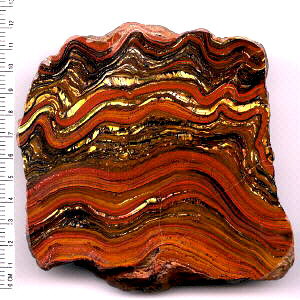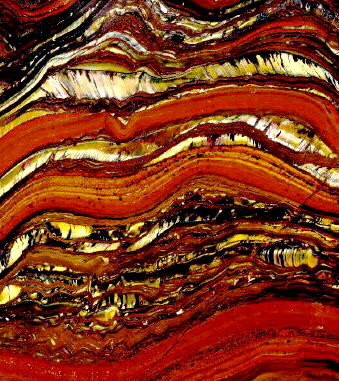Tiger Iron (Stromatolite)
Problematica: Is Tiger Iron definitely stromatolite?
Ord Ranges
Western Australia
Age: Archean
Click on images to Magnify
Discussion:
Stromatolites are laminated fossils formed by blue-green
algae and sediment. Sediment sticks to the surface of the
living algae, forming a crust. In turn, the algae grows through
the sediment to form a new layer of living matter. A new
film of sediment sticks to the algae and so on. The resulting
structure looks like a mound. In cross section,
each layer can be seen.
Stromatolites are the most abundant fossils known from the
Precambrian. They are less common in the Paleozoic, perhaps
because snail-like predators began to graze on the algae.
Geologic Range: Archean to Recent
Is Tiger Iron definitely stromatolite?
The determination is not definitive and even the experts are
are not in agreement on such determinations. (The folds may
be of tectonic origin.)
Tiger Iron could easily be both BIF (Banded Iron Formation)
and
stromatolite, in the sense that the layers are prerserved because
they were trapped by mats of microbes living on the seafloor.
Because most stromatolites are believed to have been formed by
mats of cyanobacteria and other microbes (cyanobacteria are
photosynthesizers and give off free oxygen as a waste product,
like ordinary plants). BIF deposition in the interval from 2.5
to 1.8 billion years ago is tied to the story of rising levels of
oxygen in the atmosphere.
The following two paragrpahs copied from
Nebraska's Invertebrate Fossils
Dr. Roger K. Pabian
Algae are very important producers in the marine environment's
food
chain. Through photosynthesis, by using energy from sunlight, algae
can convert carbon dioxide and important nutrient elements such as
Carbon, Magnesium, Hydrogen, Oxygen, Potassium, Iodine, Nitrogen,
Calcium and Iron into carbohydrates and proteins that sustain all animal life.
Algae are very important fossils in helping geologists
and paleontologists
to understand the ancient environments of depositions and ecosystems
that existed in the geologic past. The kind of algae present in a rock can
give the geologist some idea as to the depth of water in which the rock
was deposited. Some wavelengths of light penetrate the water column
deeper than other wavelengths. Different species of algae photosynthesize
at different wavelengths of light. For example, red wavelengths of light
penetrate deeper than blue wavelengths so a species of algae that used
only red wavelengths would suggest it lived in deeper water.
Viewer Comments:
Stromatolites are produced by microbial assemblages,
mostly dominated by blue-green algae, but the stromatolite
is really a sedimentary deposit. In effect, they are trace fossils
produced by the sediment-trapping character of the microbial
mat. In my own teaching manuals I list stromatolites under
Trace Fossils. If you want to indicate them as the products of
blue-green algae (cyanobacteria), then list it under Kingdom
Monera (for prokaryote microbes).
Dr. Tom E. Yancey
Very interesting. I've never heard the interpretation that
Tiger Iron was a stromatolite before. Do you have a
reference in the literature for this. It is reasonable based
on the laminar structure of the tiger iron.
Your specimen is quite outstanding.
Dr. Roger K. Pabian
Is Tiger Iron definitely stromatolite?
As a field collector and minor student
of stromatolites and
banded iron formations I will address this issue and give my opinion.
In recent years I have visited an iron mine repeatedly,
went to iron belts
made up of green stone, and held over 2,000 pounds of banded irons
in my hands from a few locations (Michigan's UP, Mary Ellen Mine,
Atlantic City iron mine, Bradley Peak irons). These locations are
2 - 2.87 billion years old.
Having fair knowledge of stromatolite appearance, and good
exposure to three locations of Archean age stromatolites I feel
comfortable in offering my opinion.
With out a microscope and thin slice work I base my opinion
on
field studies and a 10X loupe. I go with the anaerobic bacteria being
close enough to plants in nature to call it stromatolite. The time is
about 3.5 billion years ago, the Prokaryotae and Archea (by 2.5 billion
has established it self), so it is iffy either way but from field fondling
specimens and cutting and polishing, I go with stromatolite. I can't
back it up with chemistry, which is the full clue.
I believe it will take more field studies and lab work to
prove
stromatolites are of banded iron formation but it will probably
be proven. It will happen, just not today. Heck, we only learned
of plate tectonics 40 years ago.
Dave Freeman
That is a very nice and aesthetic specimen. I have seen
stromatolite slabs at the Tuscon show that are very large.
Some are slabbed to make coffee table tops.
Mark Palatas
Stunning!! That is the best I have ever seen.
Roger Jones
http://www.btinternet.com/~vendian/FOSSILWEB/
Go-Back
Fossil Menu
Other
Fossils (USA and World Wide)

